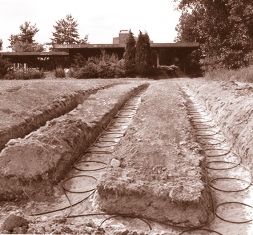Editor’s Note: When I shared my remembrances of my mother in my June 2011 ezine, I was worried some may have thought it too personal, but your feedback was quite positive. So here are some remembrances of my father who was a trailblazer (quite literally) in green design.
My father was a bit of an oddball; his personality was an extraordinary mix of the musician’s bohemian attitude toward life and the scientist’s strict need for proof. He was opinionated, and frequently had innovative ideas, only some of which could be realized successfully.
So one day when my father pulled up with a bulldozer and truckloads of huge coiled tubing, a pump and a compact machine he called a heat exchanger and started ripping up the lawn, the equipment’s appearance didn’t surprise us as much as it triggered a response of, “What now!?” It was 1968 and we were embarking on my family’s venture into sustainable energy.
Our home in Denmark was a single story, flat-roofed modern brick and wood house fueled by a flow-through oil furnace. Floor-to-ceiling windows with double vacuum pumped glass panes made up the two longest walls of the house and met in a corner overlooking the pond and the wetlands park that bordered the property. A 1.5 meter roof overhang braced us from the sun during all seasons and white gravel kept the roof cool in the summer.
 The house had a 1,200 square foot L-shaped main living area that served as the dining, living, and music rooms. A 10-foot-high pitch pine folding door offered the option of dividing the open space. Despite full length drapes and area rugs, the room was always cold so we kept the folding door closed for most of the winter. An open fireplace did not help the cold-hot air exchange either. Yet my father-like the rest of us-loved the expanse and the view through the large windows in the winter which would reflect light off the snow into the dining area. So thus began the quest to look for an alternative solution for heating the house.
The house had a 1,200 square foot L-shaped main living area that served as the dining, living, and music rooms. A 10-foot-high pitch pine folding door offered the option of dividing the open space. Despite full length drapes and area rugs, the room was always cold so we kept the folding door closed for most of the winter. An open fireplace did not help the cold-hot air exchange either. Yet my father-like the rest of us-loved the expanse and the view through the large windows in the winter which would reflect light off the snow into the dining area. So thus began the quest to look for an alternative solution for heating the house.
Which brings us back to the bulldozer. After its arrival, our lawn was lowered about two meters to be filled in again after tubes were snaked back and forth in neat rows and detoured into the skating pond. The “Sea-monster,” as we soon named our geothermal system, entered the house through the basement. Here, the heat exchanger met an unfinished part of the foundation facing the pond which was built like a box, with upper and lower lids made to slide inside each other to accommodate for both seasonal movement in the ground and continual sinking.
Our modest unit back in 1968 was little more than an inverted refrigerator hooked up to the boiler system via a pump. Although we could not squeeze enough heat out of the system to exclude using oil, the water that circulated through the ground and the pond raised the temperature a few degrees, enough for my father to justify the expense since we did use a little less. The experiment was noted to be a success, but it was by no means cost efficient.
There has been much debate whether geothermal systems would be a viable choice in the United States. Four decades after my father’s early experiment, the system concepts and basic components have changed little over the years. The tubing, heat exchangers and general lay-outs have been refined to create more effective, albeit initially expensive, solutions for heating commercial buildings, but despite what my father might think, the question remains whether harvesting geothermal energy is a realistic economical alternative for individual home owners.
